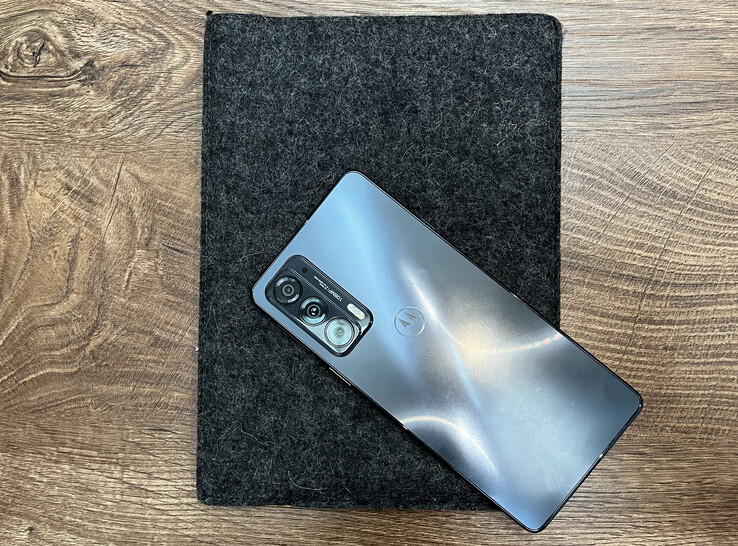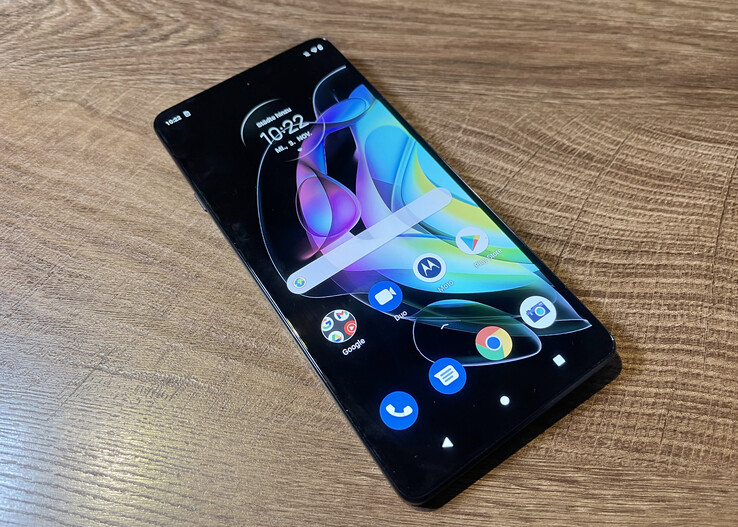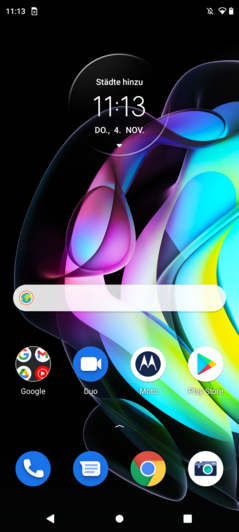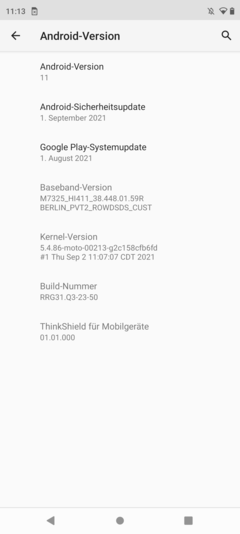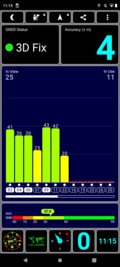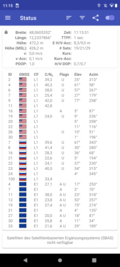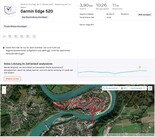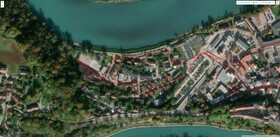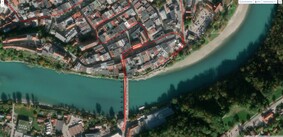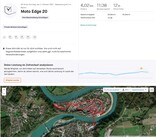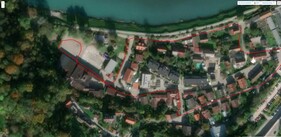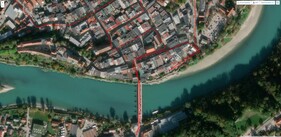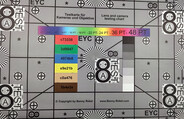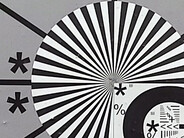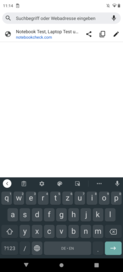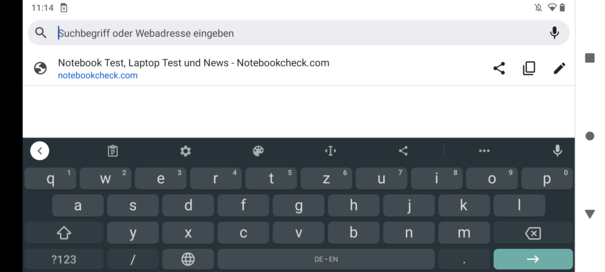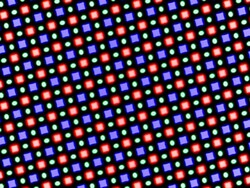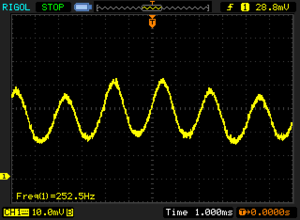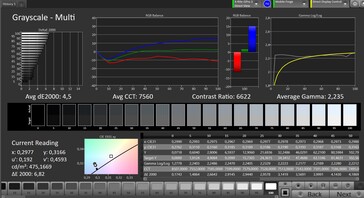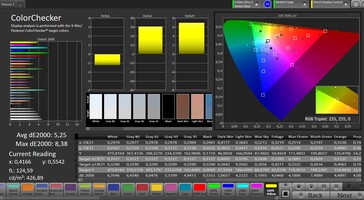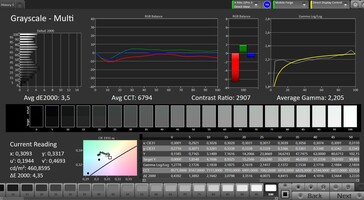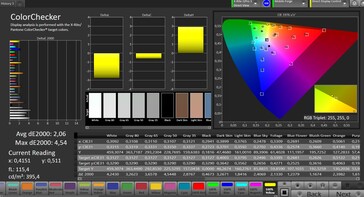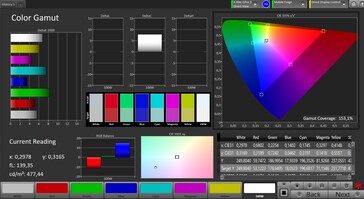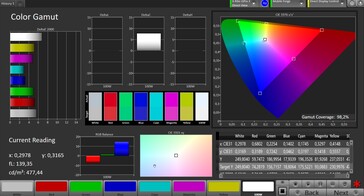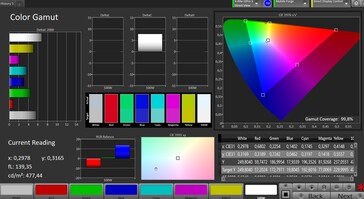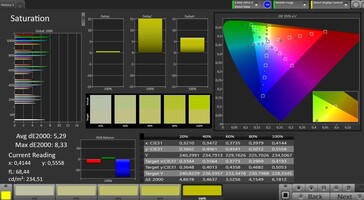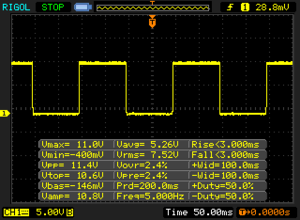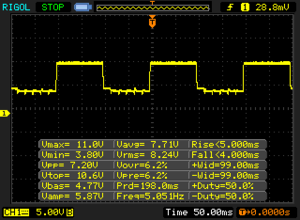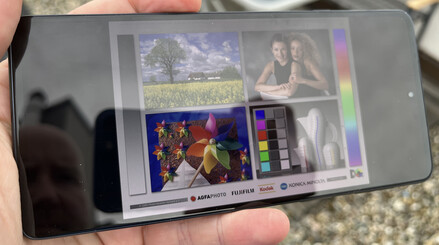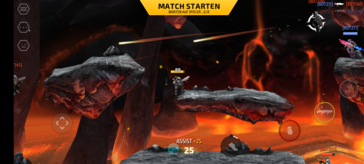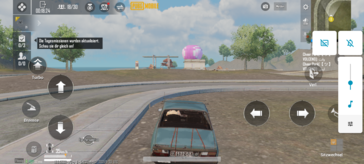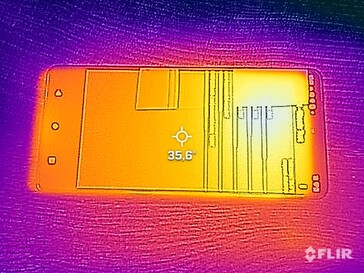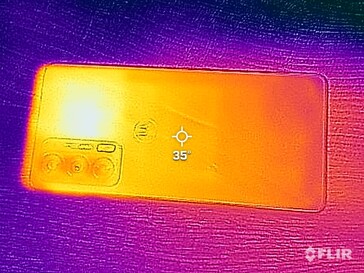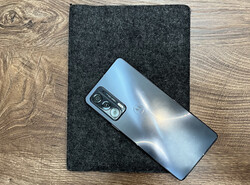Motorola Edge 20 smartphone review: Lightweight smartphone with fast display
We actually thought that Motorola interpreted the "Edge" in the name of its most premium smartphone series as a requirement to curve the display glass at the sides to make the "Edges" particularly interesting. Instead, the American-Chinese manufacturer surprised us with the Edge 20, since it now sports a flatter display.
It looks like Motorola rather focused on the fact that "edge" can also mean "lead", which is exactly what it wants to strengthen compared to other high-end mid-range smartphones.
Its particularly slim build and fairly light weight with a large display should help achieve this. Motorola fans might now recall the Moto Z series, which had smartphones that were only 5.2 millimeters thick, excluding the camera module.
The Edge 20 isn't quite as thin, but it's comparatively cheap at just under 500 Euros (~$572) and equipped with 5G as well as a flexible camera system.
Possible contenders in comparison
Rating | Date | Model | Weight | Drive | Size | Resolution | Price |
|---|---|---|---|---|---|---|---|
| 84.2 % v7 (old) | 11 / 2021 | Motorola Edge 20 SD 778G 5G, Adreno 642L | 163 g | 128 GB UFS 2.1 Flash | 6.70" | 2400x1080 | |
| 81 % v7 (old) | 05 / 2020 | Motorola Edge SD 765, Adreno 620 | 190 g | 128 GB UFS 2.1 Flash | 6.70" | 2340x1080 | |
| 86.9 % v7 (old) | 10 / 2021 | Motorola Edge 20 Pro SD 870, Adreno 650 | 185 g | 256 GB UFS 3.1 Flash | 6.70" | 2400x1080 | |
| 82.2 % v7 (old) | 05 / 2021 | Samsung Galaxy A72 SD 720G, Adreno 618 | 203 g | 128 GB UFS 2.0 Flash | 6.70" | 2400x1080 | |
| 85.1 % v7 (old) | 08 / 2021 | OnePlus Nord 2 5G Dimensity 1200, Mali-G77 MP9 | 189 g | 256 GB UFS 3.1 Flash | 6.43" | 2400x1080 | |
| 85.9 % v7 (old) | 05 / 2021 | Xiaomi Mi 11 Lite 5G SD 780G 5G, Adreno 642 | 159 g | 128 GB UFS 2.2 Flash | 6.55" | 2400x1080 |
Case – Completely reimagined
The Motorola Edge 20 is a 6.70-inch smartphone with an only slightly curved 2.5D screen. Its design is quite different from that of its predecessor: While the screen of the Motorola Edge had very curved edges and a rather rounded exterior, the Edge 20 is more angular and has a shiny metallic back with an engraved Motorola logo.
The manufacturer uses Gorilla Glass 3 for the display glass, so there's still a lot of room for improvement in terms of shatter resistance compared with more recent versions. The frame is made of an aluminum alloy, while the back is only made of plastic. The Edge 20 Pro features higher-quality materials, but the combination is very similar in comparably priced smartphones.
Once again, the smartphone is certified according to the IP52 standard, which means that it's quite well protected against dust, yet only against splashing water, so it shouldn't be immersed in water.
The Edge 20 is especially interesting because of its slim silhouette and low weight. However, the camera module protrudes from the case considerably, and naturally, that doesn't leave much room for the battery.
Connectivity – No microSD reader in the Edge 20
As before, there's no microSD card reader, but in return, Motorola offers 8 GB of RAM and 128 GB or 256 GB of mass storage this time. However, the larger storage variant is only available directly from the manufacturer, and the upgrade costs approximately 50 Euros (~$57).
The 3.5 mm audio jack has fallen victim to the slim design, and only the USB-C port can be used for connecting wired headphones or speakers. Bluetooth 5.2 and NFC are also available.
Software – Quite pure Android 11 with Moto app
Motorola runs a relatively pure version of Android 11, and any special functions are available within the Moto app, which can also be used to control additional gestures, the notifications screen, and other functions.
Our review sample's security patches are from September 2021, which means that they are no longer entirely up to date at the time of testing.
Communication and GNSS – Motorola phone with 5G on board
The Edge 20 supports 5G and also offers many 4G frequencies, so that it can be put to good use when traveling abroad. The smartphone's reception quality isn't quite on par with some high-end smartphones in the test, but it's still very decent.
In terms of WLAN, you can enjoy Wi-Fi 6, which is a modern standard for Wi-Fi networks. The smartphone is a bit faster than the Motorola Edge predecessor and roughly on par with the Edge 20 Pro. There are certainly even faster mid-range devices, but the Edge 20 delivers good Wi-Fi speeds overall.
Outdoors, it only takes a few seconds for the positioning module to determine our location with an accuracy of a few meters.
In addition, we check the positioning accuracy by going for a bike ride. The Garmin Edge 520 is included as a comparison device. Our result: The Motorola Edge 20 does a good job, but it's a bit inaccurate overall and tends to get off the road at times. It should suffice for everyday use, but users who want very accurate tracking should look elsewhere.
Telephone and call quality – Good voice reproduction
Since Motorola is using a relatively pure vanilla Android version, the phone app is also from Google. It's easy to manage calls and contacts with it, and since the app is used by many manufacturers, you don't need to familiarize yourself with it in many cases. VoLTE and VoWiFi are available.
The smartphone delivers impressive voice quality: Both the earpiece and the built-in speaker for hands-free calls sound good, and they reproduce the other person's voice without any background noise. Our voice is also transmitted cleanly, although we need to be careful not to speak too softly.
Cameras – No OIS for the Edge 20's main camera
At first glance, the camera systems of the Edge 20 and Edge 20 Pro Pro appear to be very similar. The 108-megapixel main camera is indeed identical, but the Edge 20 Pro has a periscope zoom camera, something the Edge 20 can't offer. It only has 3x zoom, but the f-stop is better, so that more light can be captured with the zoom camera.
However, this also means that the Edge 20 doesn't have an optical image stabilizer for its main camera, since it's only available for the telephoto camera. Depending on the usage scenario, this can be a significant disadvantage.
Photos taken with the main camera in good light look less vivid than those of the iPhone, but you could also say that they look a bit more natural, so this is probably a matter of taste. The sharpness is okay in detail, but by no means perfect. The brightness and details are quite good for this class in low light. Overall, it's possible to take decent photos in a wide range of scenarios that are at a mid-range level.
Thanks to the wide-angle and telephoto lenses, you also have slightly more flexibility in terms of field of view. However, you shouldn't expect to be able to recognize distant details well with the wide-angle camera, because it's too inaccurate for that.
Videos can be recorded at a maximum of 4K and 30 fps, 60 fps is only available in Full HD. The brightness and sharpness adjustment works well. Nevertheless, the microphones pick up quite a bit of noise when the camera is in motion.
Image comparison
Choose a scene and navigate within the first image. One click changes the position on touchscreens. One click on the zoomed-in image opens the original in a new window. The first image shows the scaled photograph of the test device.
Main camera - PlantMain camera - SurroundingsMain camera - Low lightWide-angle cameraThe Edge 20's main camera has to prove itself in the lab as well. Detail reproduction is not perfect here either, but it's acceptable. You can hardly make out anything in the pictures at an illumination of 1 lux.
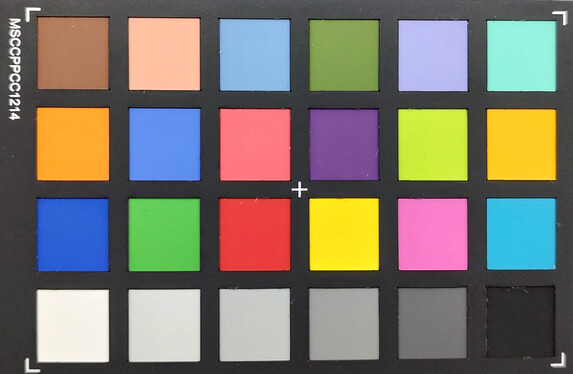
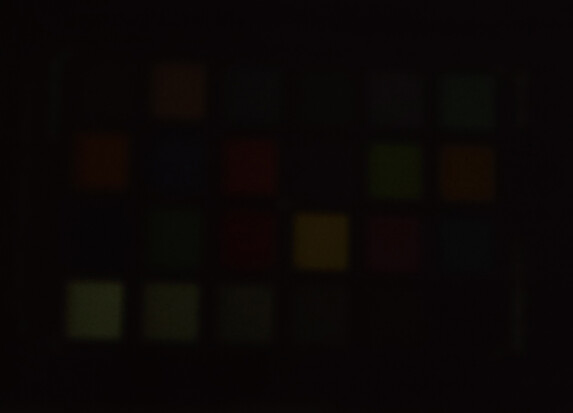
Accessories and warranty – Motorola phone with warranty extension available
The Motorola Edge 20 supports "Ready For", which means that it displays an interface optimized for large screens when a monitor is connected either with a cable or wirelessly, thereby making it easier to use the device. Of course, Bluetooth keyboards and mice can also be connected.
The box includes a charger and a USB-C cable, as well as a SIM tool. Motorola doesn't offer any special accessories, except for a replacement charger for about 20 Euros (~$23).
Motorola provides a standard warranty of 24 months. Users can improve protection with MotoCare; comprehensive accident protection and an extended warranty are available for between 25 (~$29) and 60 (~$69) Euros. Three different levels are available here.
Input devices and handling – Fast fingerprint scanner
Google's standard app is used as the virtual keyboard. Users who prefer to use a different keyboard from the Play Store can naturally do so as well.
The fingerprint sensor used for unlocking the device is integrated into the standby button on the smartphone's side. It responds very precisely and quickly to registered fingerprints. Unlocking the smartphone is also very fast in standby mode. When setting it up, however, you should be careful not to accidentally press the standby button, otherwise the smartphone screen will turn off and you will have to restart the registration process.
Face recognition is also supported, but there are some limitations here (problems when wearing sunglasses or face masks, the smartphone has to be held upright, etc.), so it's recommended to set up the fingerprint scanner at least as a second authentication option if you want to save time.
Display – Fast but with moderate brightness
Motorola equips the Edge 20 with an OLED display that sports a wider Full HD resolution. The display has a refresh rate of up to 144 Hz, which makes it look very smooth when scrolling and in videos that have been adjusted for this purpose. Users who want to save power can also lower the refresh rate to 60 Hz or leave the decision to the system. In the latter case, the refresh rate is dynamically adapted to the content, so it's reduced in still pictures and increased when scrolling quickly.
Like in the predecessor, the display's brightness is less compelling: 480 cd/m² is fine for everyday use, but it's not enough for HDR reproduction. Other mid-range smartphones like the Samsung Galaxy A72 or the Xiaomi Mi 11 Lite 5G demonstrate that much more can be done in this respect.
| |||||||||||||||||||||||||
Brightness Distribution: 94 %
Center on Battery: 479 cd/m²
Contrast: ∞:1 (Black: 0 cd/m²)
ΔE ColorChecker Calman: 2.06 | ∀{0.5-29.43 Ø4.77}
ΔE Greyscale Calman: 3.5 | ∀{0.09-98 Ø5}
153.1% sRGB (Calman 2D)
Gamma: 2.205
CCT: 6794 K
| Motorola Edge 20 OLED, 2400x1080, 6.7" | Motorola Edge AMOLED, 2340x1080, 6.7" | Motorola Edge 20 Pro OLED, 2400x1080, 6.7" | Samsung Galaxy A72 Super AMOLED, 2400x1080, 6.7" | OnePlus Nord 2 5G AMOLED, 2400x1080, 6.4" | Xiaomi Mi 11 Lite 5G AMOLED, 2400x1080, 6.6" | |
|---|---|---|---|---|---|---|
| Screen | -50% | 32% | -7% | -5% | 13% | |
| Brightness middle (cd/m²) | 479 | 427 -11% | 666 39% | 730 52% | 594 24% | 863 80% |
| Brightness (cd/m²) | 480 | 438 -9% | 644 34% | 734 53% | 594 24% | 860 79% |
| Brightness Distribution (%) | 94 | 94 0% | 93 -1% | 97 3% | 99 5% | 93 -1% |
| Black Level * (cd/m²) | ||||||
| Colorchecker dE 2000 * | 2.06 | 5.34 -159% | 1.4 32% | 3.2 -55% | 2.74 -33% | 3.2 -55% |
| Colorchecker dE 2000 max. * | 4.54 | 9.33 -106% | 2.65 42% | 8.8 -94% | 6 -32% | 5.2 -15% |
| Greyscale dE 2000 * | 3.5 | 4 -14% | 1.9 46% | 3.5 -0% | 4.2 -20% | 3.9 -11% |
| Gamma | 2.205 100% | 2.315 95% | 2.209 100% | 2.05 107% | 2.278 97% | 2.33 94% |
| CCT | 6794 96% | 7221 90% | 6646 98% | 6605 98% | 7322 89% | 7299 89% |
* ... smaller is better
Screen Flickering / PWM (Pulse-Width Modulation)
| Screen flickering / PWM detected | 252.5 Hz | ||
The display backlight flickers at 252.5 Hz (worst case, e.g., utilizing PWM) . The frequency of 252.5 Hz is relatively high, so most users sensitive to PWM should not notice any flickering. However, there are reports that some users are still sensitive to PWM at 500 Hz and above, so be aware. In comparison: 53 % of all tested devices do not use PWM to dim the display. If PWM was detected, an average of 8084 (minimum: 5 - maximum: 343500) Hz was measured. | |||
As is typical for OLED displays, the panel also flickers at higher brightness levels, but Motorola has implemented a DC-dimming mode that can be activated in the display settings; it can help relieve headaches or eyestrain in sensitive users. Nevertheless, you should still try out the display before buying the device if you've had problems with this in the past.
We use the CalMAN software to measure the display's color reproduction. Motorola provides several color profiles, and the color temperature can also be adjusted by the user via the settings. White color reproduction looks a bit too green in the "Natural" mode when you look very closely. However, this will probably be negligible for most users. Overall, color reproduction is quite accurate and at least on a par with the competition.
Display Response Times
| ↔ Response Time Black to White | ||
|---|---|---|
| 6 ms ... rise ↗ and fall ↘ combined | ↗ 3 ms rise | |
| ↘ 3 ms fall | ||
| The screen shows very fast response rates in our tests and should be very well suited for fast-paced gaming. In comparison, all tested devices range from 0.1 (minimum) to 240 (maximum) ms. » 17 % of all devices are better. This means that the measured response time is better than the average of all tested devices (20.2 ms). | ||
| ↔ Response Time 50% Grey to 80% Grey | ||
| 9 ms ... rise ↗ and fall ↘ combined | ↗ 5 ms rise | |
| ↘ 4 ms fall | ||
| The screen shows fast response rates in our tests and should be suited for gaming. In comparison, all tested devices range from 0.165 (minimum) to 636 (maximum) ms. » 21 % of all devices are better. This means that the measured response time is better than the average of all tested devices (31.6 ms). | ||
Performance – Mid-range power in the Motorola phone
With the Qualcomm Snapdragon 778G 5G, Motorola has chosen an upper mid-range SoC for the Moto Edge 20. This provides a decent performance leap compared with the predecessor, but it will be noticed primarily in more demanding scenarios such as when multitasking, for example.
The Adreno 642L is installed as the graphics unit. The "L" at the end indicates slightly lower performance than with the standard Adreno 642, which can actually be observed in our benchmarks as well when you compare the Moto Edge 20 with the Xiaomi Mi 11 Lite 5G. That said, our review sample's power is also significantly higher than the predecessor's, allowing it to keep up well with other devices in its class.
| AnTuTu v8 - Total Score (sort by value) | |
| Motorola Edge 20 | |
| Motorola Edge | |
| Samsung Galaxy A72 | |
| OnePlus Nord 2 5G | |
| Xiaomi Mi 11 Lite 5G | |
| Average Qualcomm Snapdragon 778G 5G (422597 - 452805, n=5) | |
| AImark - Score v2.x (sort by value) | |
| Motorola Edge 20 | |
| Motorola Edge 20 Pro | |
| Samsung Galaxy A72 | |
| OnePlus Nord 2 5G | |
| Xiaomi Mi 11 Lite 5G | |
| Average Qualcomm Snapdragon 778G 5G (136987 - 140376, n=6) | |
The Moto Edge 20 proves to be quite fast when browsing the Internet, especially considering the comparison devices. Although you sometimes have to wait for images to load when scrolling in practice, users will generally be able to browse the Internet quickly with the smartphone.
| Jetstream 2 - 2.0 Total Score | |
| Average of class Smartphone (23.8 - 387, n=147, last 2 years) | |
| Motorola Edge 20 Pro (Chrome 94) | |
| Motorola Edge 20 (Chrome 95) | |
| Xiaomi Mi 11 Lite 5G (Chrome90) | |
| Average Qualcomm Snapdragon 778G 5G (58.8 - 86.8, n=11) | |
| OnePlus Nord 2 5G (Chrome 92) | |
| Motorola Edge (Chrome 81) | |
| Samsung Galaxy A72 (Chrome 90.0.4430.91) | |
| JetStream 1.1 - Total Score | |
| Motorola Edge 20 Pro (Chrome 94) | |
| Motorola Edge 20 (Chrome 95) | |
| Xiaomi Mi 11 Lite 5G (Chrome90) | |
| Average Qualcomm Snapdragon 778G 5G (102.6 - 155.3, n=7) | |
| OnePlus Nord 2 5G (Chrome 92) | |
| Motorola Edge (Chrome 81) | |
| Samsung Galaxy A72 (Chrome 90.0.4430.91) | |
| Speedometer 2.0 - Result 2.0 | |
| Average of class Smartphone (15.2 - 643, n=119, last 2 years) | |
| Motorola Edge 20 Pro (Chrome 94) | |
| Xiaomi Mi 11 Lite 5G (Chrome90) | |
| Motorola Edge 20 (Chome 95) | |
| Average Qualcomm Snapdragon 778G 5G (52.5 - 61.5, n=9) | |
| OnePlus Nord 2 5G (Chome 92) | |
| Motorola Edge (Chome 81) | |
| Samsung Galaxy A72 (Chrome 90.0.4430.91) | |
| WebXPRT 3 - Overall | |
| Average of class Smartphone (38 - 380, n=30, last 2 years) | |
| Motorola Edge 20 (Chrome 95) | |
| Motorola Edge 20 Pro (Chrome 94) | |
| Average Qualcomm Snapdragon 778G 5G (93 - 131, n=10) | |
| Xiaomi Mi 11 Lite 5G (Chrome90) | |
| Motorola Edge (Chrome 81) | |
| OnePlus Nord 2 5G (Chrome 92) | |
| Samsung Galaxy A72 (Chrome 90.0.4430.91) | |
| Octane V2 - Total Score | |
| Average of class Smartphone (2228 - 126661, n=194, last 2 years) | |
| Motorola Edge 20 Pro (Chrome 94) | |
| Motorola Edge 20 (Chrome 95) | |
| Average Qualcomm Snapdragon 778G 5G (23915 - 31915, n=11) | |
| Xiaomi Mi 11 Lite 5G (Chrome90) | |
| OnePlus Nord 2 5G (Chrome 92) | |
| Motorola Edge (Chrome 81) | |
| Samsung Galaxy A72 (Chrome 90.0.4430.91) | |
| Mozilla Kraken 1.1 - Total | |
| Samsung Galaxy A72 (Chrome 90.0.4430.91) | |
| Motorola Edge (Chrome 81) | |
| OnePlus Nord 2 5G (Chrome 92) | |
| Xiaomi Mi 11 Lite 5G (Chrome90) | |
| Average Qualcomm Snapdragon 778G 5G (1323 - 1893, n=11) | |
| Motorola Edge 20 (Chrome 95) | |
| Motorola Edge 20 Pro (Chrome 94) | |
| Average of class Smartphone (257 - 28190, n=154, last 2 years) | |
* ... smaller is better
The storage speed of the Moto Edge 20 is average for its class, although devices equipped with UFS 3.0 or UFS 3.1 are much faster. This means that larger amounts of data can be read and written quickly, but other smartphones can do it even faster.
| Motorola Edge 20 | Motorola Edge | Motorola Edge 20 Pro | Samsung Galaxy A72 | OnePlus Nord 2 5G | Xiaomi Mi 11 Lite 5G | Average 128 GB UFS 2.1 Flash | Average of class Smartphone | |
|---|---|---|---|---|---|---|---|---|
| AndroBench 3-5 | -16% | 34% | -45% | 70% | 13% | -30% | 134% | |
| Sequential Read 256KB (MB/s) | 1011 | 941 -7% | 1699 68% | 490.8 -51% | 1827 81% | 949 -6% | 761 ? -25% | 2235 ? 121% |
| Sequential Write 256KB (MB/s) | 471.4 | 451.7 -4% | 723 53% | 260 -45% | 1256 166% | 710 51% | 296 ? -37% | 1871 ? 297% |
| Random Read 4KB (MB/s) | 190.2 | 150.5 -21% | 245.7 29% | 119.2 -37% | 223.7 18% | 207.9 9% | 154 ? -19% | 297 ? 56% |
| Random Write 4KB (MB/s) | 210.6 | 145.2 -31% | 179.6 -15% | 114.7 -46% | 239 13% | 206.9 -2% | 130.4 ? -38% | 343 ? 63% |
Games – 120 fps is achievable
The 144 Hz display is actually ideal for gamers who are looking for high fps rates in order to gain an advantage over their opponents, especially in fast paced games. Unfortunately, it's currently difficult to use these types of displays in mobile games, since phone manufacturers often limit frame rates due to the high battery consumption, and app developers need to optimize their games accordingly as well.
We test frame rates with GameBench's software, and we discover that you can actually get quite high frame rates of 120 fps in the 2D shooter Armajet with the Edge 20. PUBG, which is more demanding, still allows 60 fps at low settings.
Controlling games via the touchscreen and position sensor works very well.
Emissions – No throttling on the Edge phone
Temperature
The case heats up to 44 °C (~111 °F) under prolonged load, which isn't critical yet, but we did measure this at moderate room temperature. Heat development is likely to be even higher on hot summer days, and holding the smartphone in the hand or carrying it around in the pocket could definitely become uncomfortable then.
At least performance isn't affected by this: The frame rates remain quite constant, even after several runs of 3DMark Wild Life.
(±) The maximum temperature on the upper side is 42.2 °C / 108 F, compared to the average of 35.2 °C / 95 F, ranging from 21.9 to 247 °C for the class Smartphone.
(±) The bottom heats up to a maximum of 44 °C / 111 F, compared to the average of 34 °C / 93 F
(+) In idle usage, the average temperature for the upper side is 26.8 °C / 80 F, compared to the device average of 32.9 °C / 91 F.
3DMark Wild Life Stress Test
| 3DMark | |
| Wild Life Stress Test Stability | |
| Xiaomi Mi 11 Lite 5G | |
| Motorola Edge 20 Pro | |
| Samsung Galaxy A72 | |
| Motorola Edge 20 | |
| OnePlus Nord 2 5G | |
| Wild Life Extreme Stress Test | |
| Motorola Edge 20 Pro | |
| Motorola Edge 20 | |
| Xiaomi Mi 11 Lite 5G | |
| OnePlus Nord 2 5G | |
Speaker
Compared to the predecessor, the mono speaker in the Edge 20 is a bit louder in our tests, as well as more balanced when it comes to highs in particular. However, the possibility for stereo effects is gone; only the speaker at the bottom is used.
And how does it sound in practice? Unfortunately, it's average at best and also quite high-pitched. Although some audio effects can be adjusted in the settings, they don't provide any noticeable improvement.
We recommend using external audio devices. Unfortunately, the 3.5 mm audio jack from the predecessor is no longer available, leaving the USB-C port or Bluetooth as the only options for audio output. Audio quality is clean here, and modern codecs for Bluetooth are installed with aptX HD and aptX Adaptive.
Motorola Edge 20 audio analysis
(+) | speakers can play relatively loud (84.5 dB)
Bass 100 - 315 Hz
(-) | nearly no bass - on average 22.4% lower than median
(±) | linearity of bass is average (11% delta to prev. frequency)
Mids 400 - 2000 Hz
(+) | balanced mids - only 3.8% away from median
(±) | linearity of mids is average (7.8% delta to prev. frequency)
Highs 2 - 16 kHz
(±) | higher highs - on average 8% higher than median
(±) | linearity of highs is average (7.5% delta to prev. frequency)
Overall 100 - 16.000 Hz
(±) | linearity of overall sound is average (20.3% difference to median)
Compared to same class
» 33% of all tested devices in this class were better, 9% similar, 57% worse
» The best had a delta of 11%, average was 35%, worst was 134%
Compared to all devices tested
» 52% of all tested devices were better, 8% similar, 40% worse
» The best had a delta of 4%, average was 24%, worst was 134%
Motorola Edge audio analysis
(±) | speaker loudness is average but good (80.5 dB)
Bass 100 - 315 Hz
(-) | nearly no bass - on average 23.7% lower than median
(±) | linearity of bass is average (7.7% delta to prev. frequency)
Mids 400 - 2000 Hz
(±) | higher mids - on average 5% higher than median
(±) | linearity of mids is average (8.5% delta to prev. frequency)
Highs 2 - 16 kHz
(±) | higher highs - on average 5.5% higher than median
(±) | linearity of highs is average (8.9% delta to prev. frequency)
Overall 100 - 16.000 Hz
(±) | linearity of overall sound is average (22.5% difference to median)
Compared to same class
» 48% of all tested devices in this class were better, 6% similar, 46% worse
» The best had a delta of 11%, average was 35%, worst was 134%
Compared to all devices tested
» 65% of all tested devices were better, 6% similar, 29% worse
» The best had a delta of 4%, average was 24%, worst was 134%
Battery life – Little room for the battery
Energy consumption
The Edge 20 is on par with the competition in terms of energy consumption. Especially under full load, but also on the whole, it's more efficient than the OnePlus Nord 2 5G or the Xiaomi Mi 11 Lite 5G.
| Off / Standby | |
| Idle | |
| Load |
|
Key:
min: | |
| Motorola Edge 20 4000 mAh | Motorola Edge 4500 mAh | Motorola Edge 20 Pro 4500 mAh | Samsung Galaxy A72 5000 mAh | OnePlus Nord 2 5G 4500 mAh | Xiaomi Mi 11 Lite 5G 4250 mAh | Average Qualcomm Snapdragon 778G 5G | Average of class Smartphone | |
|---|---|---|---|---|---|---|---|---|
| Power Consumption | -11% | 18% | 3% | -14% | -14% | -26% | -27% | |
| Idle Minimum * (Watt) | 1 | 1 -0% | 0.7 30% | 0.86 14% | 0.8 20% | 0.83 17% | 1.106 ? -11% | 0.847 ? 15% |
| Idle Average * (Watt) | 1.3 | 1.4 -8% | 0.9 31% | 1.82 -40% | 1.2 8% | 1.92 -48% | 2.07 ? -59% | 1.448 ? -11% |
| Idle Maximum * (Watt) | 1.6 | 2 -25% | 1.2 25% | 1.86 -16% | 1.6 -0% | 1.97 -23% | 2.32 ? -45% | 1.633 ? -2% |
| Load Average * (Watt) | 3.9 | 4.8 -23% | 4.6 -18% | 2.95 24% | 5.7 -46% | 3.84 2% | 4.17 ? -7% | 6.96 ? -78% |
| Load Maximum * (Watt) | 7.2 | 7.3 -1% | 5.5 24% | 4.87 32% | 10.9 -51% | 8.6 -19% | 7.81 ? -8% | 11.3 ? -57% |
* ... smaller is better
Energy consumption: Geekbench (150 cd/m²)
Energy consumption: GFXBench (150 cd/m²)
Battery life
The Edge 20 loses some ground in terms of runtimes due to its rather small 4,000 mAh battery, but it doesn't do a bad job overall and still manages acceptable battery life with 12 hours in our Wi-Fi test. The smartphone should certainly make it through a workday, and if you charge it every night anyway, battery life should be more than sufficient.
Nevertheless, it's still a fact that the battery capacity is low and that the Galaxy A72, for example, offers twice the runtime in idle usage and is otherwise much more powerful in everyday use.
The battery can be recharged at a maximum of 30 watts, which means that a full charge is achieved in just under one hour.
| Motorola Edge 20 4000 mAh | Motorola Edge 4500 mAh | Motorola Edge 20 Pro 4500 mAh | Samsung Galaxy A72 5000 mAh | OnePlus Nord 2 5G 4500 mAh | Xiaomi Mi 11 Lite 5G 4250 mAh | |
|---|---|---|---|---|---|---|
| Battery runtime | 31% | 10% | 48% | 27% | 8% | |
| Reader / Idle (h) | 25.7 | 41.9 63% | 28.2 10% | 52.6 105% | 32.1 25% | 25.2 -2% |
| H.264 (h) | 18.4 | 20 9% | 21.5 17% | 18.9 3% | 18.8 2% | 20.8 13% |
| WiFi v1.3 (h) | 11.9 | 14.8 24% | 12.9 8% | 14.6 23% | 16 34% | 12.2 3% |
| Load (h) | 3.1 | 4 29% | 3.3 6% | 5 61% | 4.5 45% | 3.7 19% |
Pros
Cons
Verdict – The Edge 20 is slim and unusual
In our review, the Motorola Edge 20 proves to be a mid-range smartphone that differs from its predecessor in more ways than just its looks.
It's a light and slim smartphone, so users who are looking for something like that should keep an eye out. In return, however, you have to sacrifice battery life, and there is no longer a 3.5 mm audio jack, either. The design features a flatter screen with clearer edges now, and it looks a bit more premium than the predecessor.
The speaker system has been downgraded to a mono speaker, and it doesn't manage to be fully persuasive, nor does the display's maximum brightness. In return, you get high frame rates in games and a generally very smooth image reproduction due to the 144 Hz display.
The Edge 20 is a slim phone with a fast 144 Hz display and slightly short battery life.
Performance is at mid-range level and can clearly surpass that of the predecessor; there's no need to put up with throttling under prolonged load. The camera system is flexible, and call quality is decent. In addition, you get a bonus feature in Motorola's mid-range: "Ready For", which can be used when you want to connect the smartphone to a larger screen and use it as a PC replacement.
The Edge 20 is a smartphone with pros and cons, and you should take a close look at the aspects that are particularly important in a phone to you before buying one. Alternatives are the OnePlus Nord 2 5G and the Xiaomi Mi 11 Lite 5G. The predecessor is quite a different smartphone compared to the Edge 20, so you can certainly save money when buying the Motorola Edge, but you should compare the devices in detail beforehand.
Price and availability
Motorola Edge 20
- 08/31/2022 v7 (old)
Florian Schmitt




